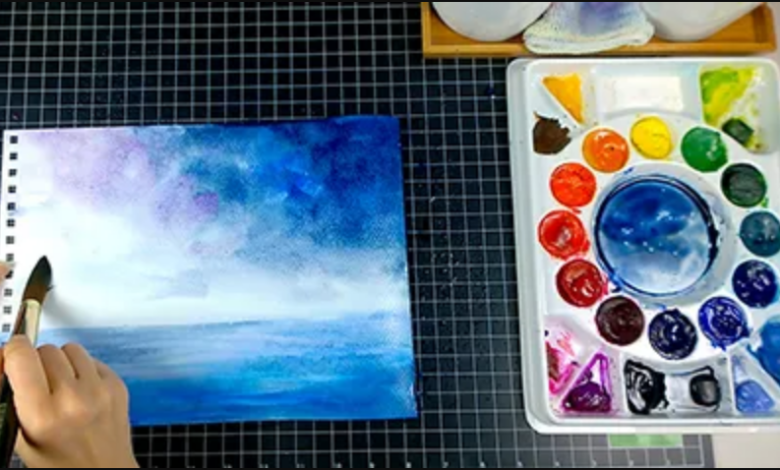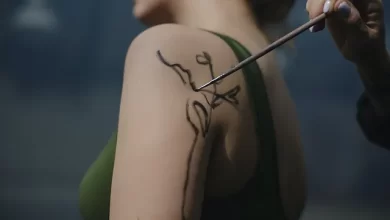Watercolor for mixed media art

Watercolor for mixed media art. Mixed media artists quickly discover creative awards for their artistic watercolor paper, collage, monoprops, and more. The watercolor versatility enables different surfaces and connects to other means and materials to shine. Best of all, the watercolor is not limited to pots or tubes. You can get overtime watercolor effects from pencils, crayons, sticks, and powder. If you are newly new to mixed media or in your work of art for years, including these tips and techniques, add a bit, fun and fresh ideas for your practice.
Make a watercolor escort.
Danielle Donaldson supports a stock of watercolor backgrounds construction for future use in mixed media techniques. In his book, creative girls: Mixed-Media – techniques for an artistic life, he explains why: “There are times when I feel less than creative. Creating colors and beautiful patterns on paper is a healing path from a crisis with the additional bonus of various variables for future work. To create, with a loose wash, the color on the paper begins, then adds more colors and mixtures for the paper. When washing dries, clear water and colorful strikes on the paper, then salt sprinkle, pull the color, pull a spotty effect. Use as it is or cut the background and use it in the collage, collage pages of art, or canvas.
Power supply.

The powdered pigments are hot objects under the artists working with watercolor, mixed media. They discover the fantastic watercolor effects achieved by mixing the pigments with water; the rich, saturated colors; and the fact that a bit goes a long way. Jane Davenport road tested to the explosive color of Ken Oliver Crafts in September / October 2015 of the magazine fabric paper scissors, creating a watercolor palette by a little, water pigments mixing on a pallet and paints a portrait with him. It is also the mixture of pigment/water used as a spray and creates a random and bright background in Dauber.
All colors
We know it’s hard to resist new colorants, but Cathy Johnson said that fine-scale when it comes to watercolors. Do not worry about all the rainbow colors, and with more, he says in his book, painters sketchbook: exercises and techniques for sketching on site. “Learn colors you want is a part of the fun and a big part of learning, time mixing a hot and fresh each main color, or just one of everyone if you choose good ..” She has good advice: go for the best quality color you can; if you are on a fixed budget, go for preamections and some other key colors. Added burnt Sienna and the Payne Gray on its base palette and mixed.
Close the resistance
Resist funds and watercolors were determined for each other. Let him add to Joanne Sharpe’s lettering in the mixture. In the September / October 2014 Journal of Cloth Paper Scissors, Joanne shows several ways to create fat and unique letters with the resistance agents such as rubber cement, airbrushed, Washi band, and crayons. After writing the words, paint something above the mask with a watercolor wash and mix analog colors. If dry, use an eraser or a clean, dry cloth or airbrushed rubber kitty to wipe off or gently pull the tape. Do not stop there. Add more text, doodles, and color for an even bold piece.
Mix it up
Another way to create a resist with watercolor consists of an opaque support or acrylic semigloss. Melanie Head recommends cleaning and drying the center on watercolor paper. Because an unfinished area is formulated on paper when painted with watercolor creates amazing drawing ideas. In his book dreaming magazine: Converting the books cater book offers even more tips: Matte ship, is a bit more than in all suctions and leaves a sound on the sound quality, while the means for creating a semibondo window in the former paint layers.
Help in the kitchen
The use of watercolor Danielle Donaldson for mixed media begins with a substrate that has probably never been thought of: paper towels. For a romantic and colorful garland, start with a watercolor pool on a whiteboard, then with a towel to mop paper, which repeats the process to sufficient towels. After drying towels, the plies are emptied, cut into strips, and Kucili together with a sewing machine into strips and Kucili. To do this, tear two strips on top of another and sew the center, Crinchiando randomly and bend the upper level on a collected and messy aspect. In his article Tumbled Blossom Garland, in the issue of March / April 2016 of the fabrics shear magazine, Danielle also shows how to use watercolors with ribbon roses and leaves watercolor paper.
Sweep away
Gina Rossi Armfield took one of the largest watercolor properties and turned it into a signature technique. In his book, there is no excuse for aquarell: painting techniques for sketching and journaling show very wet colors to create a random rivulet that proposes the movement. Paint a simple form like a heart with a light color. While the first layer is still wet, it falls on an average color. Use the still-wet color, edge form with darker color; this leads to a blooming effect. Then lift the paper and lift the blowing air in short, strong explosions in the direction you want the dribbling. When the paper is completely dry, use the drops to add the writing with a waterproof pen.
Look at the sky
To paint a Seascape watercolor, it’s easy to follow the Gina-Lee Kim techniques to create water and sky. In art decline 2: The versatility of the blue focuses on the movement of Pennellati during painting. She paints in a diagonal direction to make a wind look in the sky. A large washing brush or a large round brush is extremely useful to achieve this effect. Use rich and try not to overload the color. He adds, takes your biggest round brush, and applies a varied laundry for the sky and in an upward movement. Generates linear shorts below the horizon line to the sea. It creates a first washing of the color foundation.
Words are important
The water-soluble pencil and pastel are fantastic to write words on one side that can add meaning to a work of art. In his book no excuses animals, Watercolor: A field guide for painting, Gina Rossi Armfield uses this technique to add a keyword or set it in one piece: Write the word or words free with a wax portion or a water-soluble pencil. Then gently call the words with a water-filled spray bottle until they get the desired bleeding. The color should begin to dissolve and pick up a softer appearance.
Also Read: Meaningful and Effective Assignments



